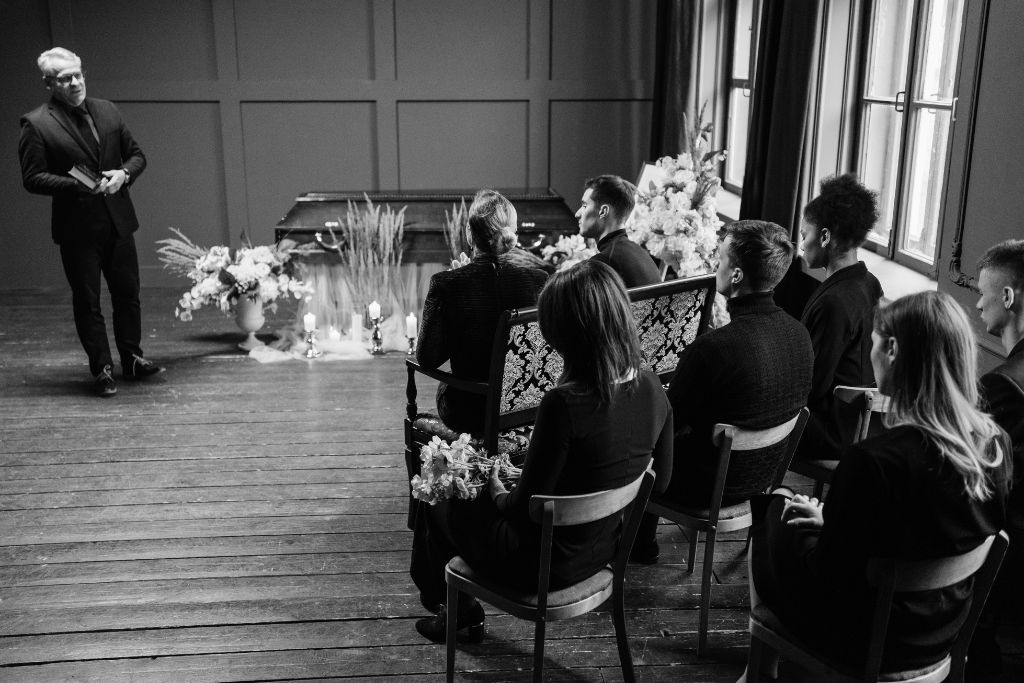Funeral etiquette provides a safe guide for behavior: it shows how to express grief and support without unnecessary words or gestures. Knowledge of general principles also helps navigate different religious and cultural customs and express empathy in a manner appropriate to the situation. Proper behavior at a funeral is a form of compassion — one that is expressed not only through words, but also through silence, gesture, and presence.
Funerals in the Catholic Church – customs and traditions
In the Catholic understanding, death is not the end but a passage to eternal life. The funeral ceremony usually consists of three parts: the liturgy held in a church or chapel, the procession to the cemetery, and the rite of burial of the body or urn. During the funeral Mass, it is important to remain focused and silent — conversations are not appropriate, mobile phones should be turned off, and photography is allowed only with the family’s consent.
Funeral etiquette also applies to dress — black or very dark colors symbolize mourning and the solemnity of the moment. Women should wear modest clothing without deep necklines, while men should wear suits or jackets. Traditionally, the family and closest relatives order wreaths and floral tributes, while friends and acquaintances bring smaller arrangements or a single symbolic flower.
After the ceremony, a stypa (funeral reception) is held — a gathering during which loved ones remember the deceased. Attendance at this event is reserved for those invited by the immediate family.
Funeral rites in other Christian denominations
In Protestant, Evangelical, and Orthodox traditions, the funeral has a different character, although the purpose remains the same — to honor the life of the deceased and to pray for their soul.
In Protestant churches, the funeral usually consists of a funeral service held in a church or chapel, followed by the farewell at the cemetery. During the ceremony, worshippers pray, sing hymns, and read passages from the Gospel. The funeral service commemorates the deceased but is also an occasion to proclaim faith in the resurrection of Jesus Christ and eternal life, as well as to bring comfort to the family, loved ones, and all those grieving. In the Lutheran tradition, there is no custom of praying for the dead or lighting candles “for the soul of the deceased.” Participants are expected to behave respectfully, listen attentively to the Gospel, and follow the rhythm of the ceremony. If kneeling is not customary in a given community, one should refrain from doing so — funeral etiquette in this context means subtly adapting to the surroundings.
In the Orthodox Church, the funeral ceremony is longer and more solemn. The body of the deceased rests in an open coffin, over which prayers are said and mourning hymns are sung. An icon is often placed on the forehead of the deceased. At the coffin, family and friends say their final farewells and pray for the soul of the departed. During the ceremony itself, the celebrant — the priest leading the service — recites prayers and chants psalms. A distinctive element of the Orthodox funeral is the chanting of the canon known as the Trisagion, a prayer for the deceased expressing faith in their resurrection. The body is then carried on the shoulders of relatives and friends to the burial site. At the cemetery, the priest offers one final prayer before the coffin is lowered into the grave.
Behavior during the ceremony should be quiet and composed, and attire should be modest and dark. It is also appropriate to participate in the final prayer at the grave, even if one does not belong to that faith, maintaining an attitude of reflection and respect.
Funeral etiquette in Islam and Judaism
In Judaism and Islam, funeral rites are deeply connected to the belief in the sanctity of the body and the obligation to bury the deceased within 24 hours.
In Judaism, the body of the deceased is prepared by the chevra kadisha (funeral society), which washes it, dresses it in a simple white linen shroud, and places it in a plain wooden coffin — all to emphasize the equality of all people before God. A short funeral procession then takes place, during which psalms are sung. Every Jew who sees a funeral procession is expected to join it, even briefly. The funeral is conducted by a rabbi or members of the community, and participants do not bring flowers. The body is laid in the grave with the feet facing the Holy Land, and after burial, the deceased’s son recites the Kaddish prayer. After the ceremony, the family observes a seven-day mourning period (shivah), spent at home in prayer and remembrance. Visitors should enter quietly and refrain from offering words of consolation. Thus, Jewish funeral etiquette is rooted in simplicity, silence, and presence.
In Islam, the body of the deceased is washed, wrapped in a white shroud, and buried without a coffin if permitted by local law. The funeral usually takes place on the day of death, and the prayer (Salat al-Janazah) is performed collectively under the guidance of an imam or a close relative, often in an open space. The deceased is laid in a modest grave on their right side, facing Mecca. The ceremony is brief, without music or flowers. Loud mourning is discouraged. For those outside the Muslim faith, the most important thing is to show respect — remain silent and follow the instructions of the immediate family. Knowledge of Arabic prayers is not required; a calm and respectful presence is enough.
Eastern funeral traditions – Buddhism and Hinduism
In Far Eastern traditions, a funeral is primarily a spiritual journey, and death is seen as one of the stages in the cycle of life. In both Buddhism and Hinduism, the ceremonies focus on the soul’s transition to its next incarnation or state of enlightenment. There is no single, uniform model of the funeral ceremony in either culture.
In Buddhism, the body of the deceased usually remains in the home or temple for several days to allow the soul to peacefully leave the earthly realm. Prayers and meditations dedicated to the deceased play a key role, as they help the soul move on to the next life. During the funeral ceremony, monks recite sutras while incense and candles are lit. Offerings such as flowers, incense, and food are made. Silence and mindfulness are essential — participants do not kneel but remain quiet; if they wish, they may place their hands together in a prayer gesture. Clothing should be light and subdued — mourning is not marked by black but by white, symbolizing purification. Before entering the temple or the place of ceremony, it is advisable to check whether shoes should be removed or shoulders covered.
In Hinduism, death is not considered a sorrowful event but rather a joyful one, bringing the deceased closer to the supreme Hindu god, Brahma. The body is washed by the family, dressed in fresh clothes, wrapped in cloth, and adorned with flowers. The funeral ceremony often takes place outdoors, near a river. The body is cremated on a pyre, symbolizing the liberation of the soul and its transition to a new life. After cremation, the ashes are scattered into the river. Participants usually stand in silence, often with hands folded in prayer.
Although funeral customs differ around the world, their common denominator remains respect. Whether we attend a Catholic Mass, a Muslim prayer, or a Buddhist vigil, one universal rule of funeral etiquette applies — empathy, which allows us to connect across faiths in what is most human: respect for life and remembrance of those who have passed away.













